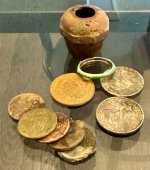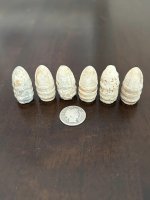coinshooter
Bronze Member
Canyon Holds Ancient Civilization Secrets
Mon Sep 20, 2:56 PM ET Add Science - AP to My Yahoo!
By PAUL FOY, Associated Press Writer
RANGE CREEK CANYON, Utah - The newly discovered ruins of an ancient civilization in this remote eastern Utah canyon could reveal secrets about the descendants of the continent's original Paleo-Indians who showed up before the time of Christ to settle much of present-day Utah.
AP Photo
Archaeologists estimate as many as 250 households occupied this canyon over a span of centuries ending about 750 years ago. They left half-buried stone-and-mortar houses and granary caches, and painted colorful trapezoidal figures on canyon walls.
"It's like finding a van Gogh in your grandmother's attic," Utah state archaeologist Kevin Jones said.
The so-called Fremont people, named after a Spanish explorer who never met them, remain a poorly understood collection of widely scattered archaic groups. Yet they represent a tenuous link to the earliest inhabitants of North America, who are believed to have arrived by way of the Bering Strait more than 10,000 years ago.
As a culture, the Fremont were distinguished by their style of basket weaving, animal-claw moccasins and farming and hunting skills.
Their everyday tools and pottery were different from the farming-dependent Anasazi south of the Colorado River — even as they shared a similar fate. Both cultures packed up and left about the same time for reasons not fully explained. What became of the Fremont and Anasazi also is a mystery.
Earliest traces of Fremont life show up three centuries before the birth of Christ, but they disappeared around A.D. 1250. This unlooted canyon — turned over by a rancher who kept it secret for more than half a century — could have been one of their final strongholds.
It also could reveal why the Fremont were driven out of Utah and possibly left in isolated pockets to die off. More recently, makeshift sites found in northwest Colorado suggest they were forced into exile by the Numic-speaking Ute, Pauite and Shoshone tribes.
Utah's Indian leaders, however, take exception to that, believing the Fremont are their ancestors. "The sacred belief is that we are all related," said Mel Brewster, an archaeologist and historic preservation officer for Utah's Goshute tribe.
Range Creek differs from other, better-known ancient sites in Utah, Arizona or Colorado because it has been left virtually untouched by looters, with the ground still littered in places with arrowheads, beads and pottery shards.
"You could stand right on it and not know it," said Corinne Springer, an archaeologist and Range Creek's new caretaker.
Until recently, Range Creek was all but unknown. An expedition from Harvard's Peabody Museum made a stop in 1929, but visited only a few sites. In recent summers, archaeologists and graduate students have quietly conducted a labor-intensive survey — keeping the area's full significance under wraps until news reports surfaced about the land transfer in June.
Archaeologists have documented about 300 sites — pit houses, granaries and petroglyphs — but they've surveyed only about 5 percent of the canyon drainage.
Among recent finds: a paddle-like wood shovel; a rare bundle of arrow shafts, found wedged in a canyon wall; a perfectly preserved beehive-shaped granary with a cap stone, still a third full with piles of parched wild grass seed and corn; and a pair of human remains from surrounding federal land.
To safeguard the canyon, the Utah Natural Resources Department is rushing to adopt a management plan that will restrict hunting, prohibit camping and require visitors to get permits and guides. The state Legislature also appropriated $152,000 for ground patrols and aircraft surveillance.
So far, the canyon's subtle charms tell two tales: traces of larger villages just off the canyon bottom and defensive retreats as high as 900 feet atop pinnacle and mesa tops, Jones said.
Archaeologists believe more carbon-dating will show the Fremont retreated to the higher positions toward the end of their tenure here, suggesting they were feeling pressure from other tribes moving through their territory.
The Fremont would have used ladders, ropes or cords to reach some of their granaries, set at impossible heights "where you risk life and limb getting to them," Utah journalist and archaeologist Jerry Spangler said.
___
On the Net:
More of the Fremont: http://gocalifornia.about.com/cs/fremont
Mon Sep 20, 2:56 PM ET Add Science - AP to My Yahoo!
By PAUL FOY, Associated Press Writer
RANGE CREEK CANYON, Utah - The newly discovered ruins of an ancient civilization in this remote eastern Utah canyon could reveal secrets about the descendants of the continent's original Paleo-Indians who showed up before the time of Christ to settle much of present-day Utah.
AP Photo
Archaeologists estimate as many as 250 households occupied this canyon over a span of centuries ending about 750 years ago. They left half-buried stone-and-mortar houses and granary caches, and painted colorful trapezoidal figures on canyon walls.
"It's like finding a van Gogh in your grandmother's attic," Utah state archaeologist Kevin Jones said.
The so-called Fremont people, named after a Spanish explorer who never met them, remain a poorly understood collection of widely scattered archaic groups. Yet they represent a tenuous link to the earliest inhabitants of North America, who are believed to have arrived by way of the Bering Strait more than 10,000 years ago.
As a culture, the Fremont were distinguished by their style of basket weaving, animal-claw moccasins and farming and hunting skills.
Their everyday tools and pottery were different from the farming-dependent Anasazi south of the Colorado River — even as they shared a similar fate. Both cultures packed up and left about the same time for reasons not fully explained. What became of the Fremont and Anasazi also is a mystery.
Earliest traces of Fremont life show up three centuries before the birth of Christ, but they disappeared around A.D. 1250. This unlooted canyon — turned over by a rancher who kept it secret for more than half a century — could have been one of their final strongholds.
It also could reveal why the Fremont were driven out of Utah and possibly left in isolated pockets to die off. More recently, makeshift sites found in northwest Colorado suggest they were forced into exile by the Numic-speaking Ute, Pauite and Shoshone tribes.
Utah's Indian leaders, however, take exception to that, believing the Fremont are their ancestors. "The sacred belief is that we are all related," said Mel Brewster, an archaeologist and historic preservation officer for Utah's Goshute tribe.
Range Creek differs from other, better-known ancient sites in Utah, Arizona or Colorado because it has been left virtually untouched by looters, with the ground still littered in places with arrowheads, beads and pottery shards.
"You could stand right on it and not know it," said Corinne Springer, an archaeologist and Range Creek's new caretaker.
Until recently, Range Creek was all but unknown. An expedition from Harvard's Peabody Museum made a stop in 1929, but visited only a few sites. In recent summers, archaeologists and graduate students have quietly conducted a labor-intensive survey — keeping the area's full significance under wraps until news reports surfaced about the land transfer in June.
Archaeologists have documented about 300 sites — pit houses, granaries and petroglyphs — but they've surveyed only about 5 percent of the canyon drainage.
Among recent finds: a paddle-like wood shovel; a rare bundle of arrow shafts, found wedged in a canyon wall; a perfectly preserved beehive-shaped granary with a cap stone, still a third full with piles of parched wild grass seed and corn; and a pair of human remains from surrounding federal land.
To safeguard the canyon, the Utah Natural Resources Department is rushing to adopt a management plan that will restrict hunting, prohibit camping and require visitors to get permits and guides. The state Legislature also appropriated $152,000 for ground patrols and aircraft surveillance.
So far, the canyon's subtle charms tell two tales: traces of larger villages just off the canyon bottom and defensive retreats as high as 900 feet atop pinnacle and mesa tops, Jones said.
Archaeologists believe more carbon-dating will show the Fremont retreated to the higher positions toward the end of their tenure here, suggesting they were feeling pressure from other tribes moving through their territory.
The Fremont would have used ladders, ropes or cords to reach some of their granaries, set at impossible heights "where you risk life and limb getting to them," Utah journalist and archaeologist Jerry Spangler said.
___
On the Net:
More of the Fremont: http://gocalifornia.about.com/cs/fremont




